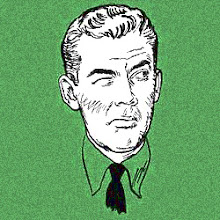 William Styron spent a year in Rome. Took a drive with friends and beloved Rose to Anzio, had a meal at a fine ristorante recommended to them. On the drive back, Styron, at the wheel of the car, hit a motorcyclist - riding a Vespa. The man flew along the hood of the car and shattered the windshield, then was flung forward and landed on the pavement just in front of the car. The man did not die but Styron was horribly shaken. After a while, a doctor in attendance, Styron saw missing fingers and an empty eye socket. "Do not worry," said the doctor (in Italian, of course), "He lost those in the last accident."
William Styron spent a year in Rome. Took a drive with friends and beloved Rose to Anzio, had a meal at a fine ristorante recommended to them. On the drive back, Styron, at the wheel of the car, hit a motorcyclist - riding a Vespa. The man flew along the hood of the car and shattered the windshield, then was flung forward and landed on the pavement just in front of the car. The man did not die but Styron was horribly shaken. After a while, a doctor in attendance, Styron saw missing fingers and an empty eye socket. "Do not worry," said the doctor (in Italian, of course), "He lost those in the last accident."Styron refused to drive for several weeks. And later he wrote this incident into the beginning of Set This House on Fire, the blockbuster Styron novel of 1960.
In the novel the motorcyclist goes into a coma, from which he awakes only at the very end of the book.
Thematically the novel is a condemnation of vulgar postwar American culture. The title comes from one of John Donne's epistles to the Earle of Carlile.
Formally it's odd and interesting: Styron at one point decided to compose the second half of the novel simultaneously in the first person and the third person. And he wrote on "dexies" - amphetamines. "I liked them," he said. He felt his pencil liberated and had access to surrealistic visions. He only took them for a week or so, since the main side effect was insomnia.
Norman Mailer hated the book even before it was published. People had been talking about Styron's next big novel (The Long March didn't quite count) after the great first book, Lie Down in Darkness. Preparing Advertisements for Myself, Mailer wrote that he's heard the new Styron novel is done. "If it is at all good, and I expect it is, the reception will be a study in the art of literary advancement. For Styron has spent years oiling every literary lever and power which could help him on his way, and there are medals waiting for him in the mass-media."
In the novel there's a Mailer-like character, Mason Flagg. Through Flagg (who says word for word a few things Mailer had said) Styron wanted to tell Mailer that he's been wasting his talent - especially hanging aesthetically around with the beat scene and modern jazz and free sex, which Styron deemed banal. So on page 124 of Set This House on Fire Styron has Flagg say something that was right out of a letter Mailer had written to Styron - a private signal to Mailer that Flagg had a message for him.
Paul Pickrel, reviewing the new Styron for Harper's, wrote: "Styron's great resource is excess." And: "The theme of the book was neatly summarized by William Blake long ago in his apothegm: 'The road of excess leads to the palace of wisdom.'"
review: July 1960 issue, p. 93; other sources including James West's excellent biography of Styron







